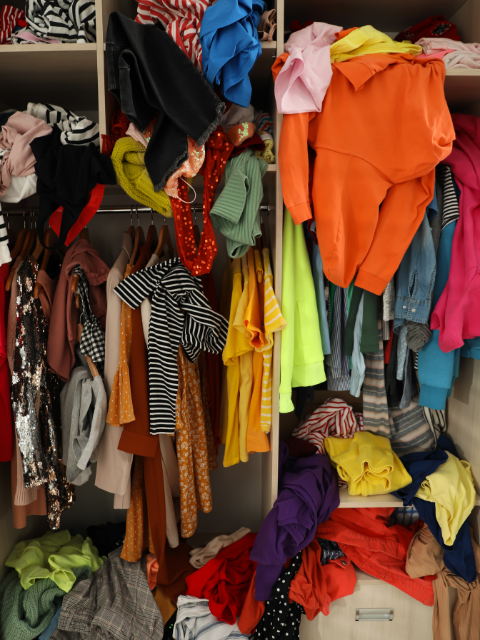This Closet as Metaphor lesson is about how divesting our closets and other living spaces of items we-don’t-really-want liberates Energy for what we-do-really-want.
In Lesson VIII, I indicated that a certain amount of visual minimalism in our living space is necessary to bring much needed harmony. Knowing that people don’t want to give up their treasured possessions to achieve this minimalism, I suggested we rotate their presentation, storing the balance in a closet (or other storage facility.)
Many people react negatively to this statement, however, noting that their closets are “bursting at the seams” and need to be cleaned out.
Two Perspectives
There are two ways to clean out a closet. Each one reveals our relationship to objects.
- The first is to rummage through the contents and remove all of the items we no longer desire.
- The second is to empty the closet completely and refill it with everything we are sure we want.
People who use the first method typically reduce the closet’s contents by about 10%. Those who employ the second method reduce them by close to 30-40%.
The Percentages Reveal Our Struggle with Things
Why the discrepancy? The difference of 10% discarded by the first method and 30-40% by the second are the objects we don’t really want but can’t give up.
Our struggle with our cluttered closets is a mirror and a metaphor of our cluttered souls. This is both good and bad news. It means that decluttering will shed guilt, irrational fear, and wistful clinging to the past.
That’s the good news. The bad news is that facing down guilt, fear, and wistfulness is precisely why it is so hard! To throw out relics of times gone by—whether it’s our grandmother’s wedding china or the broken device that seemed so state-of-the-art last year—brings us face to face with something we have already, in fact, lost.
Look at the Excuses We Use
“My first love presented this to me on our first date.”
“This was handed down to me by my parents. They saved it all their lives!”
“This will fit me again when I lose 20 pounds.”
“It’ll be back in style the moment I throw it out.”
“These might be collectibles. I’ll wait till Antiques Roadshow is in town.”
“Maybe someday I’ll want to return to my former career. I’d better save my old materials and equipment.”
“I could fix it if I could just figure out how.”
“I’ve never liked this, but I can’t afford a better one.”
“This has gone unfinished for three years. Yet, if I throw it out now, all the work I put into it will have gone to waste.”
“Yes, this book is outdated and everything in it can be found on the web, but I was taught to never throw away a book.”
“This isn’t my style, but it is far too valuable to discard.”
Living in the Present
Notice how many of these excuses pertain to the past or the future. When we hang on to something that has outlived what we want or need, we are hanging on to a belief that has outlived its relevance. We don’t want this or that item now, but we remember wanting it in the past or we imagine wanting again in the future.
Our idea of who we should be, how we should feel, and what we should want is misaligned with who we actually are right now. Outward clutter becomes the mirror for our inner clutter.
Guilt
Guilt is another common theme that freezes us in the past or the future. We might believe that we ought to value a thing because:
- Someone else once valued it.
- Someone else might value it.
- It cost a lot of money.
- Whatever project one started ought to be finished.
- Anything broken ought to be repaired — and so forth.
Giving Up the Past; Stop Looking at the Future
But, we can’t fully grow into who we are now, our present selves, until we face what we consider our losses, past or future, as Judith Viorst wrote in Necessary Losses. We must face “our conscious and unconscious losses of romantic dreams, impossible expectations, illusions of freedom and power, illusions of safety and the loss of our younger self, the self that thought it always would be unwrinkled and invulnerable and immortal,” she wrote.
Grief
Even trivial, day-to-day losses may bring on Elisabeth Kubler-Ross’s five stages of grief—denial, anger, bargaining, depression, acceptance—if for only a nanosecond. 
It might be the—
Burnt meatloaf.
The caller who hung up just as we reached the phone.
A book of misplaced stamps.
The sock that disappeared in the dryer.
The friend who forgot to save us a seat at the lunch table.
The last piece of pie that someone else ate.
The lack of expected Facebook comments or “likes.” …
Objects and Grief
When we hesitate to throw our skinny jeans on the giveaway pile, we are, in a way, wrestling with our own mortality. Then, we may have to work through:
- Denial (“If I hold my breath, I can still zip them”)
- Anger (“Baby weight is so unfair”)
- Bargaining (“I’ll go back on Weight Watchers next week”)
- Depression (“It’s hopeless. I’ll never lose the weight”)
We may have to go through those four to get to Kubler-Ross’s fifth stage, enabling us to donate our former self-image to the Salvation Army.
That’s not to say we’ll never fit into our former size again. But do we need the sight of our skinny jeans to reproach us every time we open the closet? Discarding clothes we no longer wear, for whatever reason, is about relinquishing some old idea of ourselves. Doing so enables us to accept who we are at this moment. If we shed some pounds someday, we can always celebrate with a new pair of skinny jeans!
Grief can be especially potent when dealing with the belongings of a departed loved one. We want their stuff as a sentimental attachment to them. Parting with their things somehow finalizes our loss. The best way to address this issue is to retain a few favorite items and display them with reverence.
Scarcity
Scarcity mentality is another common stumbling block. Having such barriers is particularly true for people who grew up during the Great Depression and their next generations who carry that internal code. Such largely unconscious fears lead people to treat items of little or no value as if they were irreplaceable.
For instance, they fear that they may need to return an appliance to its manufacturer as soon as we have discarded the box it came in. So we save the box and continue to save the box.
Or, they might imagine that some urgent need for paint thinner will emerge as soon as they throw away the half-empty can gathering dust for a decade.
Of course, things like that can happen once in a great while. Shortly after discarding that mystery screw, we realize what it held together. Still, it can become our rationale for hanging onto hundreds of useless items. Should the need arise, obtaining a new screw or a new box or a new can of paint thinner is not going to break the bank.
While Decluttering, We Must Be Good to Ourselves
The fact is that the emotional cost of decluttering a closet can be considerable. Many of us end up pushing whatever raises any of that guilt, fear, or wistfulness to the back of the closet and call it a day.
If we can get through the exhaustive process of letting go, however, the power of now begins delivering us Energy. That is what decluttering is all about.
Some helpful suggestions:
- Remove absolutely everything from the closet. Put back into it only those items you are sure you want.
- Give away or discard what you don’t want..
- Do not return to the closet any of the items you’re undecided about right away. Your undecided pile can amount to as much as 30 to 40 percent of the closet’s contents. Some people recommend storing the undecideds out of the way. However, such a box prolongs the decision-avoidance that overstuffed the closet in the first place. So, leave the pile where you will see it.
- After a couple of days, return to the pile and relate to it awhile. (It is best to do this early in the day, when you feel fresh.) You will probably find some emotional movement in the interim. You will find that the grief around some items has reached the stage of acceptance, so throwing it away doesn’t feel so guilty after all.
- Make the decisions that come easily, and leave the rest for another day.
- Repeat step 4 every few days. If the pile is in a room that does not overly clutter your living space, leave it there and continue the process.
- If the pile proves to be an eyesore, live with it for a week. Then, return the items to the closet.
- Try doing the whole process again in a month. The time will enable many feelings to resolve themselves. You will be surprised how much easier it will be to give up what you no longer need.
- After a couple of days, return to the pile and relate to it for a while. (It is best to do this early in the day, when you feel fresh.) You will probably find that in the interim, there has been some emotional movement. Your grief around some item has reached the stage of acceptance, and you are now ready to part with it, or you realize that throwing it away will not make you feel so guilty after all. Make any decisions that come easily. Leave the rest for another day.
***
There are two parts to this website, The Lessons which are more difficult in concept and the blogs which are lighter in nature.
- A blog that has a similar theme to Lesson X is Collecting Objects – The Purpose of Things
- A Lesson connected to Lesson X is Energy Through Our Relationship with Objects, Lesson XI.
Please note that my website allows you to leave comments at the end of the blogs but not at the end of each lesson. If you have a comment or question about a lesson, you may email me at ruta@rutas-rules.com



